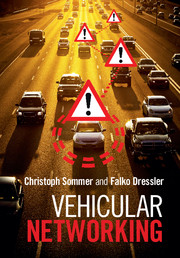2 - Intra-vehicle communication
Published online by Cambridge University Press: 18 December 2014
Summary
Electronics are playing an ever-increasing role in today's vehicles. They have gone from humble beginnings in the 1970s that saw features like electronic fuel injection and power door locks become commonplace or the mass-market introduction of anti-lock braking systems in the 1980s to today's 3 km of wiring and 50 kg of electrical systems operating in a typical modern car. With electrical systems contributing to at least one third of today's breakdowns, it is clear that modern cars just could not be driven without electronics.
The use cases that most readily come to mind might be engine control, or more recent advances in chassis electrification such as an anti-lock braking system (ABS) or an electronic stability program (ESP), maybe also modern infotainment systems like DVD players streaming video to the rear seats, navigation systems, or video cameras. Yet, modern cars contain a vast number of small electronic subsystems – from windshield wipers, door locks, power windows, and adaptive lights to seat and mirror adjustment, climate control, and dashboard displays. All these devices are controlled by electronic control units (ECUs).
Early on, this motivated the introduction of a way to diagnose faults in the electronics system, requiring digital data communication between embedded systems and diagnostic tools. Such systems were first designed for use exclusively on the vehicle assembly line and were very specific to not just the manufacturer but also the component being diagnosed. One of the earliest examples is the assembly line diagnostic link (ALDL) system used in the early 1980s for engine control module diagnosis.
The need for a digital link between ECUs and other components was further driven by the increasing complexity of connecting individual electric systems. In the early 1980s this was still easily possible using dedicated wires for each interconnection, or even for each task, but it became very clear that this would not much longer be the case; and rightly so: Today, switching on the left-turn signal involves no fewer than eight individual embedded systems.
- Type
- Chapter
- Information
- Vehicular Networking , pp. 12 - 37Publisher: Cambridge University PressPrint publication year: 2014



